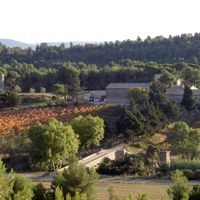Minervois 2009 – vintage report

Guest contributor
Thursday 26 November 2009
• 2 min read

Graham Nutter of Ch St-Jacques d'Albas in Laure Minervois (pictured here) reports on his experience of the 2009 growing season and harvest in Minervois. For other Languedoc harvest reports, see Languedoc 2009 – small but perfectly formed and France's 2009 vintage.
The 2009 Minervois harvest at Château St-Jacques d'Albas has been a mixed year. To begin, we had a cool and wet winter, then a cool spring, a late arrival of summer and finally a rapid catch-up of summer – but a magnificent autumn, and a high-quality harvest to reflect the post-July growing conditions.
After two years of sub-par rainfalls, we were delighted to have above-average precipitation through the winter of 2008-09 to restore water tables and give us reassurance that we wouldn't see another drought year, with all the consequences of stress on the vines, as seen in 2008 in particular. The cool winter continued through spring, with a restrained budding and flowering.
The arrival of summer gave worries too, given its below-average temperatures early on – until mid July, when summer realised that it was supposed to be warm and arrived with a vengeance. Hot days (but cool nights) through August caused a catch-up in volume and maturity of fruit. And summer turned into a mini drought, with little rain (c. 25 mm) through to the end of October. August was pretty brutal in fact, with numerous reports of water stress and sunburn on the grapes; Syrah in particular suffered (we left full top canopy for protection).
The speed of evolution in alcoholic maturity, referred to locally as the 'Usain Bolt effect', worried many, with sugar levels gaining very quickly compared with the phenolic maturation. Comparisons were being made with the 2003 harvest, given the high sugar concentrations. Into September, grapes were ripe as measured by sugars but not phenolically so, with pips still partly green. We waited – and waited, telling pickers to be patient. And then all hell let loose, as different varieties suddenly ripened, but now with the risk of shrivelling of fruit under the lack of water. The whites (our first harvest) had to be picked at very short notice, as were the later-harvested reds, with final ripening being very heterogeneous.
A need to react quickly to pick was paramount in 2009. Picking ended 5 Oct, compared with 15 Oct in 2008. Grapes came in with high sugars – but also high acidities (unlike 2003). Deep colour characterised the reds. Our oenologist characterised the harvest as being of 'very ripe fruit, particularly healthy, each red being exceptionally "varietally distinctive" and a good year for late ripeners (Mourvèdre and Carignan)'.
Sulphur was little employed. Once harvested and destemmed, the fruit went through a cold bath (10-12 ºC) for 24-48 hours to rein in the grapes' warmth and high sugars, followed by a light pumping over twice a day. Cellar work in 2009 was unusually characterised by numerous délestages (rack and return) to accelerate slow fermentation when required. With high sugars, the yeasts needed help to do their job. Our conclusion is that of our four red varieties, the Syrah is possibly the best seen since we arrived in 2001 and the Grenache, which took more time to ferment, has taken on fat and is excellent. The young Mouvèdre has shown a big jump in quality, while the Carignan (slow to mature as ever) underwent a successful carbonic maceration. All very promising.
Become a member to view this article and thousands more!
Premium
- 15,429 featured articles
- 274,064 wine reviews
- Maps from The World Atlas of Wine, 8th edition (RRP £50)
- The Oxford Companion to Wine, 5th edition (RRP £50)
- Members’ forum
Monthly
Annually
£99
Save 10% with annual membership
Professional
- 15,429 featured articles
- 274,064 wine reviews
- Maps from The World Atlas of Wine, 8th edition (RRP £50)
- The Oxford Companion to Wine, 5th edition (RRP £50)
- Members’ forum
- Commercial use of our Tasting Notes
£199
per year